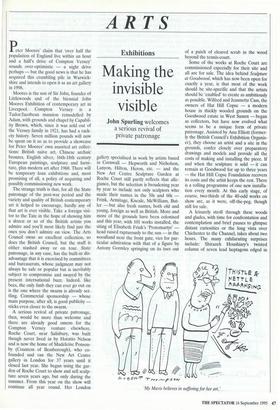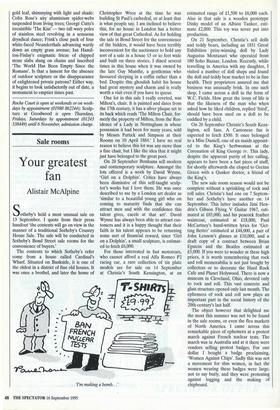ARTS
Exhibitions
Making the invisible visible
John Spurling welcomes a serious revival of private patronage titer Moores' claim that 'over half the population of England live within an hour and a half's drive of Compton Verney' sounds over-optimistic — a night drive perhaps — but the good news is that he has acquired this crumbling pile in Warwick- shire and intends to open it as an art gallery in 1998.
Moores is the son of Sir John, founder of Littlewoods and of the biennial John Moores Exhibition of contemporary art in Liverpool. Compton Verney is a Tudor/Jacobean mansion remodelled by Adam, with grounds and chapel by Capabil- ity Brown, which, since it was sold out of the Verney family in 1921, has had a rack- ety history. Seven million pounds will now be spent on it so as to provide a showcase for Peter Moores' own assorted art collec- tions: British naïve art, Chinese archaic bronzes, English silver, 16th-18th century European paintings, sculpture and furni- ture, plus modern art after 1960. There will be temporary loan exhibitions and, most promising of all, a policy of acquiring and possibly commissioning new work.
The strange truth is that, for all the State patronage of the post-war period and the variety and quality of British contemporary art it helped to encourage, hardly any of that art is ever visible. Take a foreign visi- tor to the Tate in the hope of showing him a dozen or so of the British artists you admire and you'll most likely find just the ones you don't admire on view. The Arts Council owns an excellent collection, so does the British Council, but the stuff is either stashed away or on tour. State patronage, in any case, has the built-in dis- advantage that it is exercised by committees and bureaucrats, whose judgment may not always be safe or popular but is inevitably subject to compromise and swayed by the present international buzz. Indeed, like bees, the only limb they can ever go out on is the one where the swarm is already set- tling. Commercial sponsorship — whose main purpose, after all, is good publicity sticks even closer to the swarm.
A serious revival of private patronage, then, would be more than welcome and there are already good omens for the Compton Verney venture elsewhere.
Roche Court, near Salisbury, was built though never lived in by Horatio Nelson and is now the home of Madeleine Ponson- by (Countess of Bessborough), who co- founded and ran the New Art Centre gallery in London for 37 years until it closed last year. She began using the gar- den of Roche Court to show and sell sculp- ture seven years ago, but only during the summer. From this year on the show will continue all year round. Her London gallery specialised in work by artists based in Cornwall — Hepworth and Nicholson, Lanyon, Hilton, Heron, etc. — and the New Art Centre Sculpture Garden at Roche Court still partly reflects that alle- giance, but the selection is broadening year by year to include not only sculptors who made their names in the 50s and 60s — Frink, Armitage, Kneale, McWilliam, But- ler — but also fresh names, both old and young, foreign as well as British. More and more of the grounds have been colonised and this year, with 101 works installed, the siting of Elisabeth Frink's 'Protomartyr' head raised rapturously to the sun — in the woodland near the front gate, vies for par- ticular admiration with that of a figure by Antony Gormley springing on its toes out of a patch of cleared scrub in the wood beyond the tennis-court.
Some of the works at Roche Court are commissioned especially for their site and all are for sale. The idea behind Sculpture at Goodwood, which has now been open for exactly a year, is that most of the work should be site-specific and that the artists should be 'enabled' to create as ambitiously as possible. Wilfred and Jeannette Cass, the owners of Hat Hill Copse — a modern house in thickly wooded grounds on the Goodwood estate in West Sussex — began as collectors, but have now evolved what seems to be a unique form of private patronage. Assisted by Ann Elliott (former- ly the British Council's Exhibition Organis- er), they choose an artist and a site in the grounds, confer closely over preparatory drawings and models and provide all the costs of making and installing the piece. If and when the sculpture is sold — it can remain at Goodwood for up to three years — the Hat Hill Copse Foundation recovers its costs and the artist keeps the rest. There is a rolling programme of one new installa- tion every month. At this early stage, of course, two-thirds of the 40-odd works on show are, as it were, off-the-peg, though still for sale.
A leisurely stroll through these woods and glades, with time for confrontation and contemplation and brief pauses to glimpse distant curiosities or the long vista over Chichester to the Channel, takes about two hours. The many exhilarating surprises include: Shirazeh Houshiary's twisted column of seven lead heptagons edged in My Mavis believes in suffering for her art.' gold leaf, shimmying with light and shade: Colin Rose's airy aluminium spider-webs suspended from living trees; George Cutts's irresistible 'The Kiss' — two tall wavy poles of stainless steel revolving in a sensuous dryadical dance; Frink's close pack of four white-faced Neanderthals advancing warily down an empty grass avenue; Ian Hamil- ton-Finlay's enigmatic frieze of chipped stone slabs slung on chains and inscribed `The World Has Been Empty Since the Romans'. Is that a lament for the absence of outdoor sculpture or the disappearance of enlightened private patrons? Either way, it begins to look satisfactorily out of date, a monument to emptier times past.
Roche Court is open at weekends or on week- days by appointment (01980 862244); Sculp- ture at Goodwood is open Thursdays, Fridays, Saturdays by appointment (01243 538449) until 6 November, admission charge.



































































 Previous page
Previous page